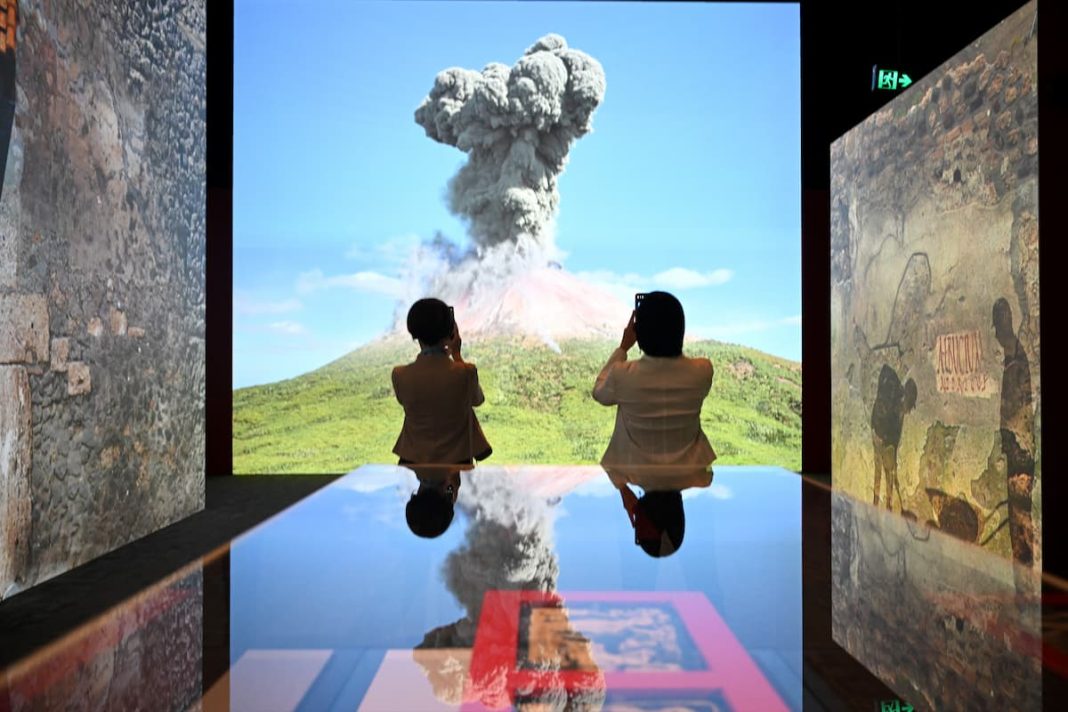Delightful frescoes and citizens buried alive can be glimpsed through a window on the world’s most complete ancient city ruins.
No longer half a world away, hundreds of thousands of visitors are expected to walk the streets of Pompeii in a summer exhibition that is like a terrifying time machine to the Roman era of gladiators, decadence and destruction.
Long-gone are the glass cases and fusty artefacts of last century as a new generation of history buffs go all-in on technical wizardry at the National Museum of Australia in Canberra.
Visceral fear is produced by the sight and sound of small pumice stones raining down on an ancient street, followed by a cathedral-sized simulation of the catastrophic eruption of Mt Vesuvius that buried the town almost 2000 years ago.
The “main avenue” of the blockbuster’s exhibition hall stretches for more than 35 metres, branching off into more intimate spaces for the dozens of objects that typify Roman refinement.
“Ancient Pompeii still captures the imagination almost 2000 years after its destruction. It is a story that has been passed down through the ages and one that keeps evolving,” National Museum of Australia director Katherine McMahon said.
Excavations at the world heritage site in Italy continue to reveal new objects, some of which have made the journey to Australia.
Hoping to inspire others, lead curator Lily Withycombe said she was “filled with awe and wonder” after going to the Australian Museum in Sydney at a young age and learning about Pompeii.
“An exhibition can change the course of (your) life,” she said, after the 1995 event set her on a path to studying archaeology, including two seasons excavating in Pompeii.
“Unlike the elite houses that I could read about and see in museums, we were exploring a once-bustling area of small and modest homes, workshops and bars.”
She left her last pair of digging boots – sturdy Aussie Blundstones – in a trench in Pompeii that the team was re-filling, as one of several contemporary objects that would make it clear to future archaeologists that it was modern work.
For Dr Withycombe, it was important that the exhibition include everyday objects that people could relate to.
“At the heart of this exhibition is real, lived, human experience, and that’s how people relate to the ancient past,” she said.
But there are also objects that really astonish, and make people think about artistic innovation and extraordinary artworks that have come out of the time.
Everyday items include a carbonised hunk of a once-white loaf of bread, pumice-encrusted pots, a terracotta frying pan and small glass perfume vessels that would have once contained costly scented oils or balms.
A lush mosaic water feature from the first half of the first century was found at a dwelling known as the house of the golden bracelet.
Figurines of gods and goddesses for the household shrine are on display alongside phallic amulets believed to bring good luck and protection from diseases, glittering jewellery, silver spoons and fresco paint pots.
Dice found in the vast house of politician Julius Polybius, one of the town’s richest men, will never be thrown.
“We’re doing something totally different with this exhibition,” Dr Withycombe said, tipping that the “digital, multimedia, immersive” experience would draw many people to the museum.
Since excavations began in the 1700s, casts of more than 100 citizens who perished have been made by injecting liquid plaster into the void they left in calcified layers of ash after their soft tissue had decomposed.
They provide some of the most haunting images of the last moments of those who once lived, worked and played in Pompeii.
Some 20,000 people were thought to have been citizens of Pompeii at the time of the eruption, but many escaped. Those that were left behind found themselves trapped by suffocating layers of volcanic ash that later solidified.
“Picture an eruptive column rising nearly 32 kilometres high, 30 times the height of the volcano,” Naples-based volcanologist Claudio Scarpati explains in one of the exhibition’s short films.
“And all the matter then dropping to the south, covering the entire city with lapilli (little stones of semi-molten lava) – this lapilli layer is a peculiarity of Pompeii.”
The “rain” of pumice stones lasted approximately 20 hours and piled up on the streets, adding about 15 centimetres per hour and burying the first floor of buildings.
Balconies offered the only escape, but then the eruptive column collapsed in on itself and all the matter – gases, ash and pumice – poured along the slopes of Mt Vesuvius at 100 metres per second and buried the town, he said.
Experts have used laser scanners and 3D printers to make copies of the casts in the 21st century, with the Canberra exhibition displaying several prone adults, a toddler and a dog in a gut-wrenching insight into the last moments of the disaster.
“It is a unique exhibition, maybe even better than the one in Paris,” Laurent Dondey, from France’s Grand Palais Immersif, said in Canberra.
First presented at the Grand Palais in Paris in 2020, it allows visitors to interact with a way of life preserved for 17 centuries under ash.
Digital and non-invasive technologies are being used in the latest excavations.
It is “rewriting the museum experience … telling a story”, he said, after more than three years of work and new scientific contributions using 3D capture, photogrammetry and X-rays.
ACT Chief Minister Andrew Barr said he expected the exhibition to be a big drawcard for tourists as well as locals, after the recent success of the record-breaking exhibitionDiscovering Ancient Egypt that topped 200,000 visits.
Pompeii will run until May 4.



